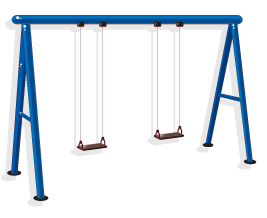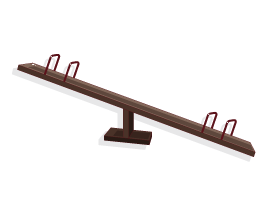The Client Relations Playground
They say that everything we need to know, we’ve learned in kindergarden. If that is true, then much of life would be like the playground. Think back to your time on the playground, or even your own children and maybe you’ll relate to some of these situations.
 The Swings
The Swings
Some projects are like the swing set. The client hops into the seat, calling out ‘push me!’ The agency starts pushing – each push is an idea, a creative asset or a part of the new campaign.
We all know what happens next. “Higher! I want to go higher,” the client calls out, so we keep pushing. Sometimes you get a client that will work with what you give them, and pump their legs. Sometimes you get a client that feels like dead weight – they want you to do all the work. Either way, this type of client is looking for one thing: the thrill of the ideas and the momentum you give them.
So how does this interaction close? Either the client gets all that they can take from you and they bail at the highest point, taking all your momentum and ideas and run off with them; or you get tired of constantly pushing while the client swings back and forth and the energy wanes.
 The Slide
The Slide
Sliders come in various sorts. The first slider knows they want to try it but is too timid. They need some convincing to get up the stairs and when they are finally faced with actually going through things, they chicken out and go back the way they came.
The second type of slider has been down this ride before. They climb up the stairs and slide down but it isn’t enough. They run in an endless loop from the end of the slide to the top and will keep doing so until their play time is up.
The third type of slider has to break the flow to assert control. They’ll climb the stairs. They’ll go down the slide, but they don’t get off. They are compelled to climb up the slide even if it makes the next person wait at the top. They want to slide down again, and then climb up again, and they don’t care who has to wait or how much mud their shoes might track on the slide.
The Merry-go-round
This one is completely our fault – we get the client on board with the project. We’re the force behind all the movement and we’re taking them for a ride – we are in control and we run with the technical jargon around and around and around. We may even get a few clients on board and try to maximize our time and efforts. At first, the experience is exhilarating but when things are going too fast, the clients feel out of control and a little sick. Some jump off before the spinning as stopped and some will stay for the long haul, but they won’t get back on, and they probably won’t let us push any more.
 The Teeter Totter
The Teeter Totter
The teeter totter is all about balance and trust. Sometimes it works, sometimes it doesn’t. Both client and agency have to agree to get on board or nothing will happen. Getting on has to be timed well to make sure someone doesn’t fall right off. Once they’re both on, participation is the only way anything happens.
The agency pushes up with an idea or creative work. The client pushes back with revisions. The Agency pushes back with changes – maybe a little less for or maybe a little more. The client responds right away based on the agency’s contribution.
Now, if both parties are mutually agreed that this experience will be pleasant, than the project can continue until both parties agree that playtime is done and its time to get off. This also requires cooperation, and the timing and execution is critical. The back and forth slow and both participants have to try and level things out so both are touching the ground. Its decided who will get off first so everyone is prepared for the shift in weight and balance. Both participants get off the board and go their separate ways having had a fun experience, knowing that the other person is someone to trust with this kind of activity again.
That’s how things work with an ideal pairing. If you pick the wrong partner, things go very differently.
Sometimes you end up with someone who is too aggressive. They push back really hard with the intention that you hit the ground hard. Sometimes they bounce on the board, destabilizing the other person. Sometimes they decide not to push and hit the ground so the other person bounces at the top. These situations are hard to deal with, because its hard to get off of this ride without the cooperation of the other participant.
The worst is when someone decides they are ending the game without planning or coordinating with the other person. Its their turn to contribute, but instead they leave their partner up in the air and then bail, causing the partner to fall suddenly.
How do we get the best playground experience possible?
- choose your playmates carefully. If you’re not sure you can trust them or they are not a good fit, you might as well move on
- know how you like to play, not just in your own mind but in writing. Choose how you want to play with others so you know what to expect
- detail out both your responsibilities and those of your playmate so both people know what they are supposed to contribute
- establish agreed upon rules so you both know how you’ll be playing
- communicate expectations at the very start so everyone knows what to expect from the start to the end of playtime
- contribute, communicate, share responsibility and built trust so that when playtime is over, you have a buddy for the
next recess.
Get In Touch
Let me know a bit about you and your project.
